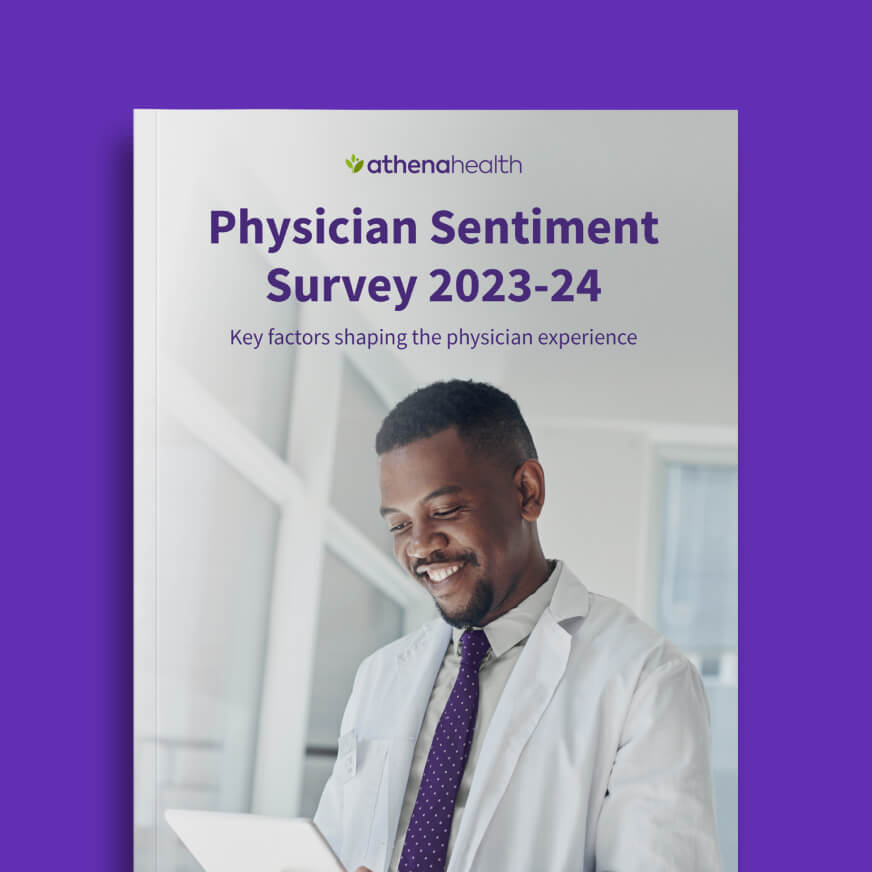Physician burnout in independent practice — challenges, impact, and solutions
Physician burnout is one of the biggest threats to independent medical practices today. Physicians and staff are stretched thin as administrative demands grow faster than resources. Lower payments from insurers can squeeze budgets, while hours are consumed by scheduling, documentation, billing follow-up, and other non-clinical tasks that keep the practice running but that can drain energy and morale — key aspects contributing to healthcare burnout in ambulatory settings.
For practice leaders, clinician burnout is a business challenge that touches every part of the organization. Productivity declines, clinician and staff turnover rises, and patient satisfaction suffers as overworked teams struggle to keep up. Left unaddressed, these pressures can harm both care quality and financial stability.
Fortunately, modern, integrated software brings clinical, operational, and financial functions together in one system. By reducing manual work, eliminating duplicate data entry, and helping teams collaborate more efficiently, tools like automated scheduling, AI-assisted documentation, and centralized dashboards can replace certain repetitive, after-hours work with smoother, more predictable workflows.
By simplifying day-to-day tasks that drive frustration, the right software not only reduces administrative burden but also helps restore purpose and balance to clinical work.
Administrative burden and clinical documentation challenges: The top causes of burnout
Physicians spend nearly twice as many hours on documentation and desk work as they do face-to-face with patients. According to the American Medical Association, ambulatory physicians spend on average 5.8 hours working in the EHR per 8 hours of patient care, with primary care physicians spending even more at 7.3 hours per 8 hours scheduled.
This imbalance fuels fatigue and frustration across the care team. Beyond clinical documentation, paperwork related to scheduling, billing follow-up, and compliance often spills into evenings and weekends. When clinicians and staff are constantly working to catch up, there is little time left for family, rest, or professional growth.
Managing separate tools for billing, EHR, scheduling, and patient communication creates extra clicks and confusion. Too many logins and poor integration add unnecessary complexity, worsening burnout.
Integrated software helps break this cycle by streamlining core workflows:
- Automated eligibility checks and claim scrubs reduce rework and speed reimbursement
- Scheduling tools and appointment reminders reduce phone load and minimize no-shows
- AI-powered documentation features, like ambient scribes, capture visit details in real time to cut hours of after-hours charting
Together, these efficiencies reclaim valuable time, lower stress, and refocus energy on patient care.
Workflow fragmentation and EHR usability: Why disconnected systems fuel frustration
Managing separate tools for billing, EHR, scheduling, and patient communication creates extra clicks and confusion. Too many logins for disparate systems and limited integration between tools add unnecessary complexity, worsening burnout.
Unified platforms like athenaOne® eliminate these silos by providing access to clinical, financial, and operational data in one system. Dashboards and task queues help staff see priorities clearly and manage workload in real time, reducing frustration and streamlining care coordination. Additionally, these platforms include tools that surface care gaps and provide patient insights during visits, empowering clinicians to address patient needs more effectively and support proactive care.
Clinicians have shared that better integration significantly improves their workflow and helps reduce after-hours work. In fact, those who believe their EHR makes them more efficient spend on average two fewer hours each week working outside of their normal business hours (14 hours vs. 16 hours) compared to those who don’t.
Together, these efficiencies reclaim valuable time, lower stress, and refocus energy on patient care.
Documentation fatigue and after-hours charting: The “pajama time” problem
Many providers face a phenomenon known as “pajama time” — the late-night hours spent catching up on charting and managing inboxes after clinic closes. This added workload takes a heavy emotional toll, worsening work-life balance and affecting long-term retention.
AI-assisted documentation and curated templates within athenaOne help lessen this burden by reducing manual notetaking. Its mobile tools enable quick updates between visits, while ambient listening features capture visit details automatically—allowing chart completion in real time rather than after hours.
Staffing strain: How burnout spreads across the team
Staff shortages and turnover create a vicious cycle: fewer people means more work, adding to burnout risks. Administrative disorder worsens stress for clinical and non-clinical staff alike.
Automation can ease this strain by handling manual tasks like eligibility checks and claim follow-up. Centralized dashboards give managers insight into workload and staffing needs, enabling more proactive resource planning. Supporting functions such as coding, billing, and prior authorization management also offer relief without adding full-time staff.
Integrated systems free clinicians to focus on care delivery and relationship-building. Tools that surface care gaps and patient insights during visits support more meaningful, efficient encounters.
Reclaiming time for patient care: Technology addresses burnout with EHR solutions for independent practices
Burnout is not just an operational issue — it’s a patient care issue. When clinicians spend more time with patients and less on paperwork, patient satisfaction and outcomes improve. Integrated systems provide actionable patient insights and highlight care gaps during visits, enabling clinicians to focus on meaningful and efficient patient interactions. Tools that surface care gaps and patient insights during visits support more meaningful, efficient encounters.
Integrated systems free clinicians to focus on care delivery and relationship-building. Tools that surface care gaps and patient insights during visits support more meaningful, efficient encounters.
Building a sustainable practice with medical software for independent practices: Culture, process, and technology
Preventing burnout requires more than one tool. It takes a purposeful strategy combining a supportive culture, smart workflow design, and the right platform.
Integrated technology supports flexible scheduling, data-driven performance management, and greater staff engagement. It empowers independent practices to operate like large health systems — without losing the personal touch and autonomy that define their identity.
Turning burnout into balance
Burnout in independent practices threatens the foundation of delivering quality care and sustaining business success. The administrative demands, fragmented workflows, and financial pressures can overwhelm even the most dedicated teams, leading to exhaustion, turnover, and compromised patient outcomes.
Fortunately, there’s a path forward. By adopting a truly integrated platform like athenaOne, independent practices can streamline clinical, operational, and financial tasks into a unified, intuitive system. This integration reduces manual work, minimizes errors, and cuts down after-hours charting.
Explore how the athenaOne unified suite simplifies workflows and restores focus on what matters most: your patients.











